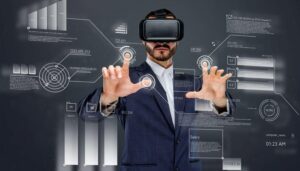The Asia-Pacific region has always been known for its pioneering spirit in innovation, and today, new technologies are revolutionizing the way people work and reshaping the skills required by employees, as well as the expectations of employers.

According to the State of HR survey, HR professionals in Asia-Pacific are actively embracing Game-Changing Technologies to enhance their operations. The survey highlights that the top areas of investment for HR professionals in the region are artificial intelligence (AI) and machine learning (34.70%), HR management systems (24.86%), and cloud-based technology (23.77%). These investments are made with the goal of improving efficiency and productivity within HR departments.
AI and machine learning play a significant role in HR functions. One of their applications is automating tedious tasks such as resume scanning. By leveraging AI, HR professionals can streamline the recruitment process by efficiently sorting through large volumes of resumes and identifying potential candidates based on predefined criteria.
HR management systems are another key area of investment. These systems provide a centralized platform for managing various HR processes, including employee records, payroll, benefits administration, and performance management. By adopting HR management systems, organizations can streamline their HR operations, improve data accuracy, and enhance overall efficiency.
Cloud-based technology is also gaining momentum in the HR landscape of Asia-Pacific. Cloud-based HR systems offer several advantages, such as increased accessibility, scalability, and data security. These systems allow HR professionals to access information from anywhere, collaborate seamlessly, and easily adapt to changing business needs.
Overall, the integration of technology in HR practices reflects the region’s commitment to staying ahead of the curve and leveraging innovative solutions. By investing in AI, HR management systems, and cloud-based technology, Asia-Pacific organizations aim to enhance their HR functions, drive operational excellence, and ultimately contribute to the success of their businesses.
Artificial Intelligence (AI)

Artificial Intelligence (AI) is a groundbreaking technology that is revolutionizing the workforce not only in the Asia-Pacific region but also globally. Its impact spans across various industries and applications, ranging from healthcare and finance to retail. For instance, Ping An Insurance in China has already harnessed the power of AI to offer customized recommendations to its customers.
According to Zhu You Gang, Senior Vice President of Ping An Property & Casualty Insurance, “Technologies will play a crucial role in transforming and upgrading the industry. They will reshape existing insurance business processes while optimizing and innovating products to deliver an enhanced service experience.”
In essence, AI is driving a significant shift in the way businesses operate in the Asia-Pacific region and beyond. Its potential is being realized through advanced algorithms and machine learning, enabling organizations to enhance their services, improve efficiency, and meet the evolving demands of customers. The adoption of AI is paving the way for a new era of innovation and growth in various sectors, ultimately shaping the future of work and business dynamics in the Asia-Pacific region.
With the continuous advancements in computing power and AI algorithms, Zhu foresees a significant improvement in insurance companies’ ability to comprehend customer needs and assess risks. This, in turn, will drive the optimization and innovation of insurance products, leading to enhanced service experiences. A noteworthy example of this is Ping An’s implementation of the “smart motor insurance claims” system. This system employs image recognition technology, big data, and AI to streamline the claims process for minor vehicular accidents. Looking ahead, as semi-autonomous and autonomous driving technologies evolve, Zhu anticipates a substantial reduction in motor insurance loss ratios. Consequently, there may be a shift in motor insurance liabilities from individual consumers to automakers, potentially necessitating a different insurance model.
Beyond enhancing efficiency and productivity, AI is also reshaping the desired skill sets sought by employers. Companies are increasingly prioritizing candidates with proficiencies in data analysis, machine learning, and natural language processing. HR professionals need to closely monitor their talent pipelines to adapt to this evolving digital landscape and ensure they can meet the changing demands of the industry.
Robotics

Robotics in the Asia-Pacific region is anticipated to achieve a market value of US$43.7 billion by 2023. Governments throughout the entire region have made substantial investments in AI research and robotics, offering tax incentives and facilitating high levels of funding. These endeavors are propelled by the escalating demand for process automation, enhanced efficiency, heightened productivity, and the establishment of cost-effective centers. Given the dominant automotive industry and the presence of economically viable manufacturing units, industrial robots are widely employed in the Asia-Pacific region. Notably, Foxconn, one of Apple’s primary contractors, has already commenced the replacement of over half a million workers with a million robots, sparking some controversy.
In a Digitimes article dating back to 2016, General Manager Dai Jia-peng of Foxconn’s Automation Technology Development Committee provided a more detailed explanation of the process and advantages. Dai stated, “In the first phase, Foxconn aims to establish individual automated workstations for tasks that workers are unwilling or unable to perform due to safety concerns.” The second phase entails streamlining production efficiency, while the third phase involves the complete automation of factories, thereby minimizing the human workforce to the bare minimum.
Robotic technology is expected to sustain its popularity and witness continued growth across the Asia-Pacific region, given its capacity to enhance efficiency and productivity in diverse industries. As governments and businesses increasingly recognize the benefits of robotics, further advancements and implementations are poised to bring about transformative changes in work methodologies.
Augmented Reality (AR) and Virtual Reality (VR)

Augmented Reality (AR) and Virtual Reality (VR) technologies have gained significant traction in various industries, including retail, healthcare, and education. In Australia, several hospitals have embraced virtual reality technology developed by Vantari VR to train medical professionals in life-saving procedures. This innovative solution has remarkably reduced training time from months to mere days, covering approximately 90% of medical procedures while adhering to college guidelines.
Vantari VR’s modules have become an integral part of doctors’ core training, delivered through the use of VR headsets and laptops. The technology has been successfully implemented in critical care units across four tertiary hospitals in Australia, namely Fiona Stanley Hospital, Nepean Hospital, Westmead Hospital, and Royal Prince Alfred Hospital.
Dr. Robert Swart, the Innovation Lead at Fiona Stanley Hospital, emphasized the tremendous advantages of being able to practice and learn life-saving procedures in a virtual reality environment before performing them on real patients. He highlighted the substantial cost savings in terms of infrastructure, equipment, and the time of educators and students associated with traditional medical education. Dr. Swart added that virtual reality enables education to take place in a small office space, where multiple educational scenarios can be instantly loaded without the need for equipment or mannequins. This self-directed education empowers learners to explore and engage in various educational experiences.
The growing popularity of AR and VR technologies is expected to persist across the Asia-Pacific region, as they provide novel ways to engage customers, train employees, and enhance overall productivity. The immersive and interactive nature of these technologies opens up new opportunities for businesses to create impactful experiences and deliver effective training programs. As organizations recognize the potential of AR and VR, further advancements and applications are likely to shape the future of various industries in the region.
Blockchain
Blockchain technology is making a significant impact across industries such as finance, logistics, and healthcare throughout the Asia-Pacific region. Analysts predict that the APAC Blockchain Technology Market will witness a remarkable compound annual growth rate (CAGR) of 54.4% during the period from 2021 to 2027.

In a noteworthy example, SBI Holdings, a Japanese securities and banking company, has strategically invested in Digital Asset, an enterprise blockchain firm based in New York. This collaboration aims to launch a joint venture called “smart yen” in East Asia, encompassing Japan and South Korea. The “smart yen” project involves the utilization of Digital Asset’s smart contract language, Daml, to establish a programmable money system. Through smart contracts, the system will automate customer loyalty programs and incentives. The partnership seeks to introduce programmable money to the Japanese market, offering a revolutionary and customer-centric cash system that directly links individual customer loyalty programs to deposits.
Yoshitaka Kitao, the president of SBI Holdings, expressed the vision behind smart yen, stating, “It will make it possible to build a revolutionary, customer-oriented cash system by directly linking each individual customer loyalty program to deposits and fully automating the process of providing loyalty through smart contracts.”
Similar to AI, the widespread adoption of blockchain technology will necessitate significant upskilling among workers in the coming years. As organizations embrace blockchain solutions, employees will need to acquire new skills and knowledge to effectively leverage the potential of this technology. The evolving landscape calls for proactive measures to ensure that the workforce is equipped with the expertise required to thrive in the blockchain-powered future.
How HR Can Prepare For The Tech That Will Change the World
In order to navigate the transformative technologies that are poised to reshape the world, HR professionals must proactively prepare themselves. Staying abreast of the latest technological advancements, such as artificial intelligence, automation, virtual reality, and blockchain, and understanding their potential impact on the workforce is essential. HR practitioners should prioritize developing their digital literacy by acquiring knowledge and skills in relevant technologies. This includes gaining an understanding of how these technologies function, their applications within HR processes, and the potential benefits and risks associated with them.
Furthermore, HR leaders should take a proactive approach in anticipating the impact of changing technologies on the workforce. This entails analyzing job roles and identifying skills that may be affected by automation or AI. By doing so, HR professionals can identify opportunities for upskilling or reskilling employees, enabling them to adapt to evolving roles and demands. Additionally, HR leaders should devise comprehensive strategies for workforce planning, talent acquisition, and talent management that account for the potential changes brought about by emerging technologies.
By diligently preparing for the future, organizations can cultivate an agile and prepared workforce that can thrive regardless of the technologies that shape their operational landscape. By embracing a proactive mindset and investing in the necessary preparations, HR professionals can effectively guide their organizations through the challenges and opportunities presented by the ever-evolving technological landscape.
In order to navigate the transformative technologies that are poised to reshape the world, HR professionals must proactively prepare themselves. Staying abreast of the latest technological advancements, such as artificial intelligence, automation, virtual reality, and blockchain, and understanding their potential impact on the workforce is essential. HR practitioners should prioritize developing their digital literacy by acquiring knowledge and skills in relevant technologies. This includes gaining an understanding of how these technologies function, their applications within HR processes, and the potential benefits and risks associated with them.
Furthermore, HR leaders should take a proactive approach in anticipating the impact of changing technologies on the workforce. This entails analyzing job roles and identifying skills that may be affected by automation or AI. By doing so, HR professionals can identify opportunities for upskilling or reskilling employees, enabling them to adapt to evolving roles and demands. Additionally, HR leaders should devise comprehensive strategies for workforce planning, talent acquisition, and talent management that account for the potential changes brought about by emerging technologies.
By diligently preparing for the future, organizations can cultivate an agile and prepared workforce that can thrive regardless of the technologies that shape their operational landscape. By embracing a proactive mindset and investing in the necessary preparations, HR professionals can effectively guide their organizations through the challenges and opportunities presented by the ever-evolving technological landscape.
nails need to prepare for these changes by staying updated on the latest technological advancements, such as artificial intelligence, automation, virtual reality, and blockchain, and their potential impact on the workforce. They should build their digital literacy by gaining knowledge and skills in relevant technologies, including understanding how different technologies work, their applications in HR processes, and their potential benefits and risks.
Most of all, HR leaders should proactively anticipate how changing technologies may impact the workforce and plan for potential changes. This may include analyzing job roles and skills that may be affected by automation or AI, identifying opportunities for upskilling or reskilling, and developing strategies for workforce planning, talent acquisition, and talent management.
By preparing for the future, the entire workforce can remain agile and prepared, no matter what new technologies impact their operating environment.
Conclusion
The rapid advancements in technology are reshaping the world and revolutionizing the way we work. HR professionals in the Asia-Pacific region are embracing these changes by investing in innovative technologies such as artificial intelligence, machine learning, HR management systems, and cloud-based technology. These investments are aimed at improving efficiency, productivity, and overall organizational performance.
The adoption of technology in HR processes, such as AI-powered resume scanning and virtual reality-based training, is streamlining operations and enhancing the employee experience. Additionally, the demand for new skills like data analysis, machine learning, and natural language processing is reshaping the expectations of employers and the skills required of employees.
Robotics, augmented reality, virtual reality, and blockchain are also making significant strides in various industries across the Asia-Pacific region. These technologies offer new opportunities for automation, improved efficiency, and enhanced customer experiences. As a result, organizations are reevaluating their talent pipelines and investing in upskilling and reskilling programs to meet the changing demands of the digital landscape.
To prepare for the future, HR professionals must stay updated on technological advancements and develop their digital literacy. By proactively anticipating the impact of changing technologies on the workforce, HR leaders can strategically plan for talent acquisition, talent management, and upskilling initiatives. By embracing these changes and preparing for the evolving technological landscape, organizations can cultivate an agile and future-ready workforce.
As the Asia-Pacific region continues to be at the forefront of innovation, HR professionals play a critical role in harnessing the power of technology to drive organizational success. By embracing technology, adapting to changing skill requirements, and fostering a culture of continuous learning, HR professionals can navigate the challenges and seize the opportunities presented by the tech-driven future. Through their efforts, organizations can thrive in the era of digital transformation and stay ahead in an ever-evolving business landscape.
FAQ
Q. How can AI and machine learning benefit HR processes?
A. AI and machine learning can enhance HR processes by automating repetitive tasks, improving efficiency in candidate sourcing and selection, enabling data-driven decision-making, and providing insights for talent management and employee engagement initiatives.
Q. What are the potential risks and challenges associated with adopting new technologies in HR?
A. Some potential risks and challenges include data privacy concerns, the need for upskilling the workforce to adapt to technological changes, potential bias in AI algorithms, and ensuring a smooth transition without negatively impacting employee morale or job security.
Q. How can HR professionals effectively prepare employees for the impact of automation and AI?
A. HR professionals can prepare employees by implementing reskilling and upskilling programs to equip them with the necessary skills for future roles. Additionally, fostering a culture of continuous learning, promoting adaptability, and providing clear communication about the organization’s vision and plans can help alleviate concerns and facilitate a smooth transition.
Q. What are the potential benefits of integrating augmented reality and virtual reality in employee training?
A. Augmented reality (AR) and virtual reality (VR) can offer immersive and interactive training experiences, allowing employees to practice and learn in realistic simulated environments. These technologies can improve knowledge retention, enhance engagement, provide hands-on training in high-risk scenarios, and reduce training time and costs.
Q. How can HR professionals ensure a successful implementation of blockchain technology in HR processes?
A. To ensure a successful implementation of blockchain technology, HR professionals should conduct thorough research, collaborate with IT teams, and identify specific use cases where blockchain can bring value, such as streamlining background checks, ensuring secure and transparent record-keeping, and facilitating efficient payroll processes. Additionally, staying updated on regulatory requirements and industry standards related to blockchain implementation is crucial.

